#mounted riflemen
Text

Rifleman
The definitive anti-aircraft 'Mech, the Rifleman was first fielded in 2505, making it among the earliest 'Mechs ever built. Designed as a medium fire-support platform, the Rifleman was plagued with a variety of problems since its debut and was ill-suited as a front-line combatant. However, its combination of long-ranged weaponry, including rapid-fire autocannons, and its excellent targeting and tracking system ensured it would remain a viable battlefield unit through half a millennium of combat.
Kallon Industries built the first RFL-1N Rifleman for the Hegemony Armed Forces, but chronic overheating problems forced a return to the drawing boards, with an improved RFL-2N introduced fifty years later. Kallon's engineers still believed the 'Mech suffered too much from overheating, and tried to fix the problem with the definitive RFL-3N by replacing some of its heat-intensive energy weapons with autocannons. Although a marked improvement, the engineers were still not satisfied with the end result and tried to produce a 'Mech which would address the issues of heat management, protection and endurance which continued to plague the Rifleman. Their response, the JagerMech, featured several improvements over the older 'Mech but did not wholly replace it, instead complementing it whenever the two served in the same unit together.
With the collapse of the Star League and start of the Succession Wars, the Rifleman was scattered amongst the militaries of the Successor States. House Davion fielded the largest concentration of Riflemen and used them to good effect in their battles with House Kurita. Unfortunately, combat losses increasingly forced many Riflemen to be deployed directly on the front-lines, where their deficiencies in close combat against similar-mass 'Mechs were apparent. After the recovery of the Helm Memory Core, rediscovered lostech was used in an attempt to improve upon the venerable Rifleman, with manufacturers deploying a number of new variants around the time of the Clan Invasion.
By the time of the FedCom Civil War, new prototypes of Rifleman variants were still being worked on, but the aging 'Mech had since acquired a poor reputation due to its weak protection and bad heat management. The 'Mech experienced something of a revival though when Kallon's factory on the moon Talon was subjected to a blockade by the 7th FedCom RCT, disrupting production of the newer JMS-7 JagerMech. The company brought up their experimental RFL-8D Rifleman to full-scale production as just a temporary measure, but the improved 'Mech wound up being fielded by both Loyalist and Allied forces during the civil war. Additional variants were introduced since then, with both the Free Worlds League and Word of Blake making use of advanced Riflemen during the Jihad.
The Rifleman's focus on fire-support and anti-aircraft work dictated a heavy load of long-range weapons to the exclusion of everything else. It carried a particularly heavy battery of two Magna Mk. III Large Lasers paired with two Imperator-A medium autocannons, one of each mounted in each arm. Two Magna Mk. II medium lasers were split between the side torsos to provide backup. One ton of autocannon ammunition was carried in the center torso, enough for short, sharp engagements but not enough for extended periods of combat. The 'Mech's ten heat sinks were grossly inadequate for constant fire, but in an anti-aircraft role, the Rifleman was expected to have time to dissipate heat while the target aircraft turned for its next pass.
The Rifleman suffered from a miserly amount of armoring - just seven and a half tons total - with its rear torso particularly thin. It also lacked hand or lower-arm actuators, hampering it in a melee confrontation, and was not particularly fast, with a cruising speed of 43.2 km/h. When operating in its intended role of providing overwatch for other 'Mechs, these deficiencies were not terribly noticeable, and it could still overpower lighter opponents by dint of its size. These drawbacks did mean that a commander would only commit their Riflemen in a head-on confrontation with heavy enemy forces as a last resort.
An exceptional piece of electronics, the Garret D2j targeting-tracking system allowed the Rifleman to maintain an accurate lock on swift-moving aerial targets and achieve excellent accuracy. The Garret T11-A was equally impressive as a communications system, although its distinctive wing-shaped design tended to draw the enemy's attention...and their fire.
The Rifleman was limited to turning its torso 40° to either side, seemingly presenting a significant blind-spot in the rear to exploit. However, its ability to flip its arms over and use those weapons to target enemies behind it presented a nasty surprise for an enemy attempting to come up and engage the 'Mech from the rear.
47 notes
·
View notes
Text

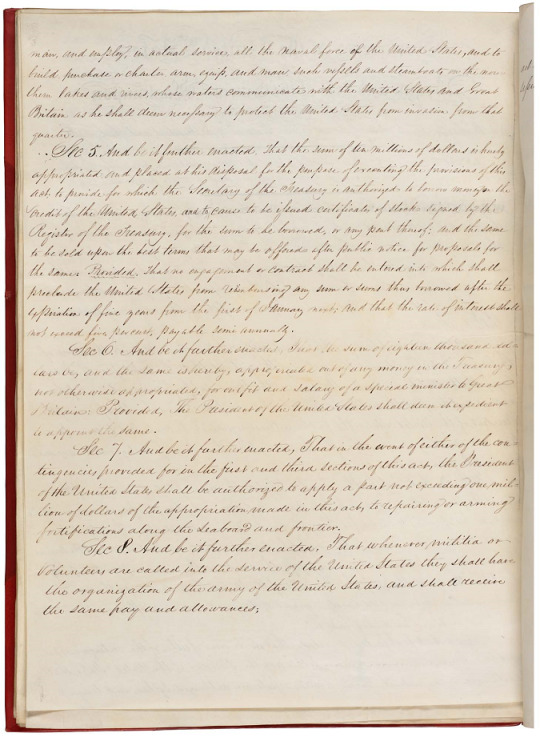
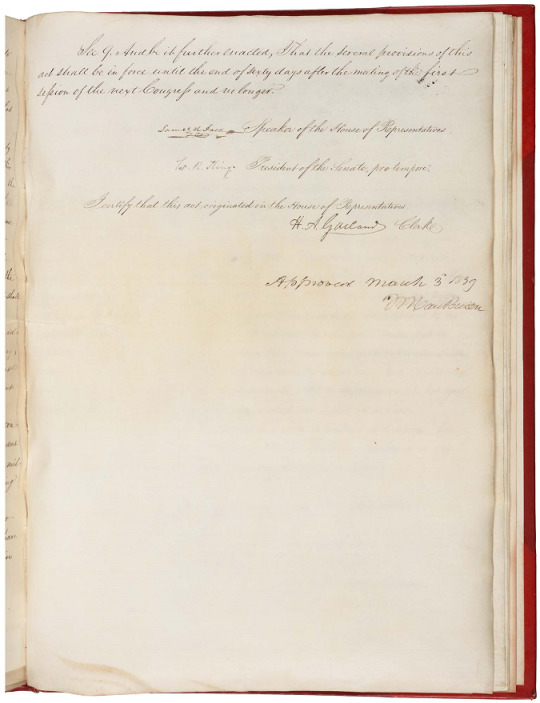
An Act Giving the President of the United States Additional Powers for the Defense of the United States
Record Group 11: General Records of the United States GovernmentSeries: Enrolled Acts and Resolutions of Congress
[handwritten pencil "1176"] Twenty Fifth [handwritten pencil "89" and right corner "Pub "82"] Congress of the United States at the Third Session Begun and held at the City of Washington in the District of Columbia on Monday the third day of December one thousand eight hundred and thirty-eight. AN ACT giving to the President of the United States additional powers for the defence of the United States, in certain cases, against invasion, and for other purposes. BE IT ENACTED by the Senate and House of Representatives of the United States of America in Congress assembled. That the President of the United States be, and he hereby is, authorized to resist any attempt on the part of Great Britain, [strikeout text] to enforce, by arms, her claim to exclusive jurisdiction over that part of the States of Maine which is in dispute between the United States and Great Britain; and, for that purpose to employ the naval and military forces of the United States and such portion of the militia as he may deem it advisable to call into service. Sec. 2. And be it further enacted. That the militia when called into service of the United States by virtue of this act or of the act entitled "An act to provide for calling forth the militia to execute the laws of the Union suppress insurrections repel invasions and to repeal the act now in force for these purposes," may, if in the opinion of the President of the United States the public interest regime it, be compelled to serve for a term not exceeding six months after the arrival at the place of rendezvous, in any one year unless sooner discharged. The "And be it further enacted, that in the event of actual invasion of the territory of the United States by any foreign power, or if imminent danger of such invasion discovered, in his opinion, to exist before Congress can be convened to act upon the subject the President be, and he is hereby, authorized if he deem the same expedient to accept the services of any number of volunteers not exceeding fifty thousand, in the manner provided for by an act entitled "an act authorizing the President of the United States to accept the service of volunteers and to raise an additional regiment of dragoons or mounted riflemen, approved May Twenty third Eighteen hundred and thirty six". Sec 4. And be it further enacted , that in the event of either of the contingencies provided for in, [strikeout text] this act the President of the United States shall be authorized to complete the public armed vessels now authorized by law, and to equip, [full transportation at link]
16 notes
·
View notes
Text
Massive Gondolend concept sketch dump
Hey look, it's my only artistic output that ever gets more than one or two notes: drawings of dinosaurs (and other animals)!


The whale-sized filter-feeding pliosaur Pelagititan melvillei (labeled here Aquatitan because I changed the name after I drew this), and the orca-sized mosasaur Zallingeria orak. These were drawn way back in 2002, before we had a better idea of what their tails were supposed to look like.

An updated orak that I started in 2016 and never got very far with because I hated it.
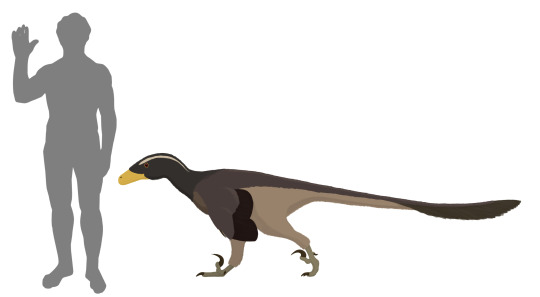
Deinonychus antirrhopus.

Yurgovuchia doellingi, which made an appearance in my short stories "The Hunter" and "The Prey."

Assultornis pteronyx, also known as the drop bird. This is a fictional dromaeosaurine found throughout the Democratic Republic of Samaraland that hunts by dropping down onto prey from above and then dragging its kill up into a tree to avoid getting it stolen by something bigger and meaner. One of these guys appears in my novella The Beasts of Kulig County, which barring any fuckups on my part I should start serializing online again in...November.

The wooly rinic, Cryonyx borealis, a fictional species of baryonychine originally native to Gondolend's frigid northern polar region, but which I have since retconned to be a southern polar animal instead. (I'll have to change that species name if I ever decide to do anything more with Gondolend beyond my current revisions.) While this drawing is relatively recent this is the first fake dinosaur I ever came up with for this project, and as you can see I went full Rule of Cool with the teeth. Which then led to...

...The horrormouth, Cryonyx phoboris. It took me years to actually draw this guy in the flesh; for the longest time it only existed as skull and skeletal reconstructions, which someone eventually tried to pass off as real on some random dinosaur battle forum.

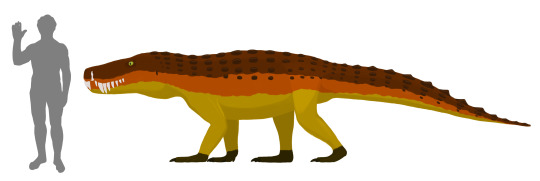
The elma'cho, Elmachosuchus gayi. This was a land-croc that I made as a reference to a gloriously stupid website that a friend of mine made and which is now gone.

I forget the scientific name for this guy, but it's commonly known as a crested dragon. It's a meter-long drepanosaur found in the Cassowary Valley, and makes an appearance in my novella Eleven Days in the Valley, which I'll be serializing on my website starting in September.
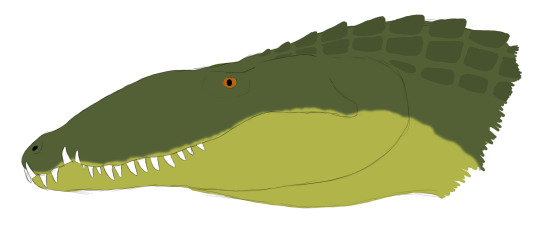
Domnosuchus, a giant land-croc native to the island of Yulan. This was the largest known species of land-croc, but it was quickly driven into extinction once humans settled the island.
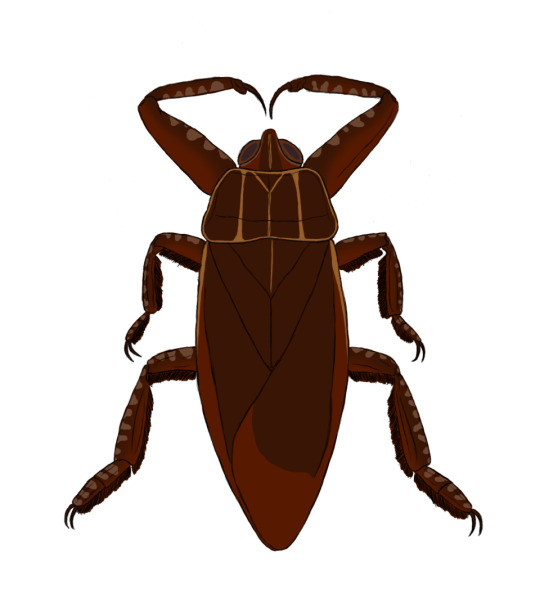
A giant water bug the size of your hand. The Isani consider them a delicacy.
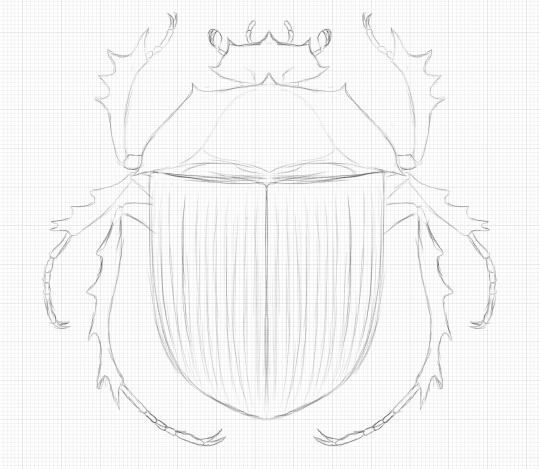
The gartum, a softball-sized dung beetle that cleans up sauropod shits on the Samara. Yes, its name is a reference to the garthim from The Dark Crystal.
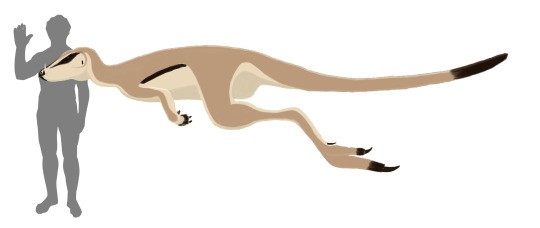
The giant hopper, Macropodotherium. This highly derived and infamously belligerent species of hypsilophodont is native to the island of Vona, but a feral population has become established in the Democratic Republic of Samaraland. These also show up in The Beasts of Kulig County. I also hate how this picture turned out and I can't fathom how I thought eschewing outlines was a good idea.



Two pterosaurs that appear in The Beasts of Kulig County, the tai (Istiodactylus) and the turu (Dsungaripterus). The tai is a full-time scavenger and generally non-aggressive, while the turu is a part-time scavenger and doesn't give a single fuck.
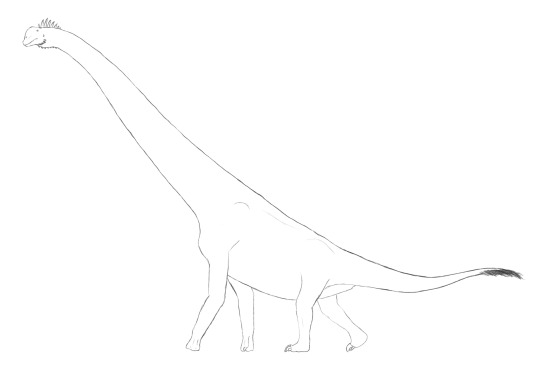
Giraffatitan, known in Samaraland as the twiga. One of these also appears in The Beasts of Kulig County.


Isisaurus, which in ancient times was used by the armies of Garacania as mobile battle platforms with archers (and, later, musketeers and then riflemen) on top.
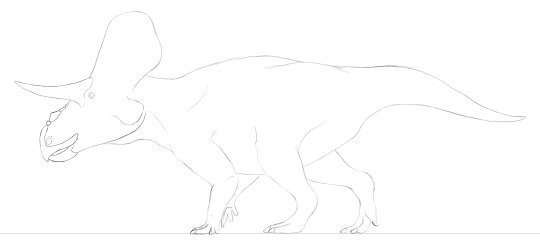
Zuniceratops, known in Garacania as the gergedat, was a popular cavalry mount. Famously, the legendary Garacani princess Denika Agares I led a gergedat cavalry into battle on many campaigns. (She also appears riding one in my short story "The Messenger.")

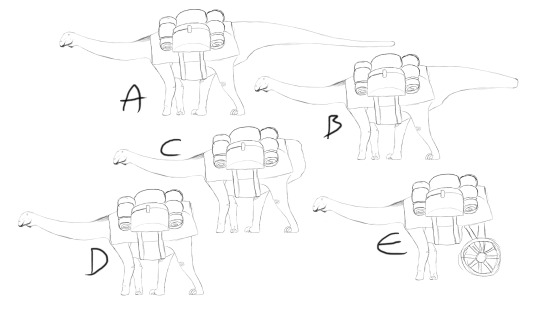
Nigersaurus was used as a beast of burden throughout Garacania (and presumably other neighboring areas), and domesticated specimens often had their tails docked at a young age to avoid them getting in the way and whapping people in crowded urban environments. The first two concepts in the second picture were serious, and the others...progressively less so.
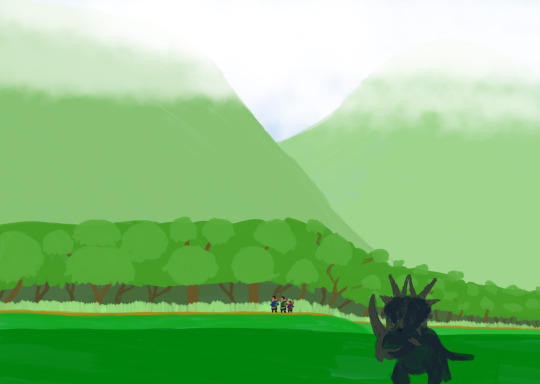
A very quick and dirty sketch of a scene in the Garacani territory of Ulaan Bok, showing several local Hahn Gar (an ethnic group inspired mainly by the Hmong) passing by as a Rubeosaurus grazes in the foreground.

An Isani boat, as seen in Eleven Days in the Valley.
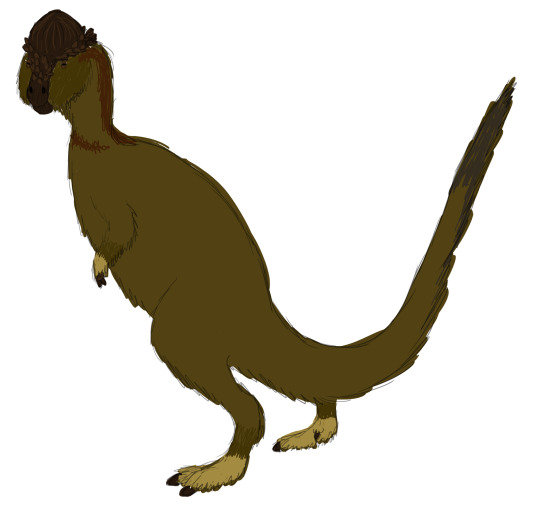
A pachycephalosaur.

I forget what I called this guy; it's a giant relative of the alligator snapping turtle native to the Cassowary Valley, where it spends most of its time on the riverbed waiting for prey to swim into its mouth. You can't see it here, but it has a very long neck.

A rough concept for a condor-sized alpine scansoriopterygid that never really went anywhere before I put my Gondolend project on indefinite hiatus.
...And that's it for now. Yeah, there's more. See you in part two, dickheads!
#gondolend#dinopunk#my art#dinosaurs#concept art#deinonychus#yurgovuchia#istiodactylus#dsungaripterus#giraffatitan#isisaurus#zuniceratops#rubeosaurus#pterosaurs#pliosauridae#mosasauridae#pachycephalosauridae#nigersaurus#speculative zoology#speculative biology#speculative evolution
7 notes
·
View notes
Note
⭐️

During the Second War, Miles Ward and Eld Candell rode together during a few missions with the 5th Mounted Blunder Brigade. They weren't called that because of mishaps or mix-ups in their missions but were one of the first to receive black powder weaponry from dwarves of Dun Morgh.
Eld along with Reece Langston had been the first to volunteer during a rescue mission into the heart of the Hinterlands to free a captured Wildhammer clansman. Miles Ward having joined a newly commisioned covert group within the burgeoning Alliance was given his first command with the mission called Operation Blue Feather. With a few others, six men and Ward had entered the troll territory in search of the captured thane. Sadly the mission turned out to be a bust as the dwarf had already tried to escape three times and paid for it with a healthy dose of wyvern poison. A mangled corpse was also the disturbing prize.
But for what they had lacked in rescuing the thane they had come upon a nest of gryphon eggs taken and a matriarch as well that the squad was able to free. A harrowing escape on gryphon back led to a marginal heroes welcome among the tattooed master of flight.
Candell, Langston, and Ward would part as comrades but definitely would end up in different parts of the world before establishing any further of a relationship. As the riflemen returned to their company and quieter days while Miles continued into a world of espionage and intrigue among SI:7.
@damien-ward
#ask answered#headcanon#eldridge candell#reese langston#miles ward#5th Mounted Blunder Brigade#Second War#the past#world of warcraft#wyrmrest accord#moon guard#roleplay#SI:7
3 notes
·
View notes
Text
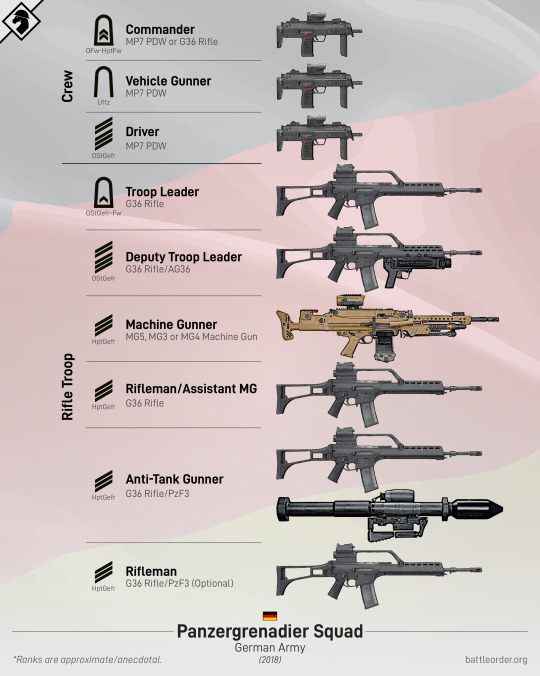
🇩🇪 The German Panzergrenadier Squad consists of the Vehicle Crew and the Rifle Troop (dismount element) with the Squad Leader (Gruppenführer) acting as the Vehicle Commander. If an operation is vehicle-centric, the Troop Leader (Truppführer) will lead the dismounts. But, if the operation is dismount-centric, the Squad Leader may lead the dismounts instead. The squads, mounted in the Puma or Marder IFV, will have 6 dismounts (one less than Jäger squads mounted in the Boxer which is 3 crew + 7 dismounts).

⚔ The MP7 personnel defense weapon appears to be a standard weapon for vehicle crews in the Bundeswehr, include tankers, IFV and APC crews. It replaced the Uzi in this role. However, there does seem to be some intention for the Bundeswehr to move to G36K Carbines for Panzergrenadier vehicle crews based on promotional displays. As for the dismounts, the Germans run a sort of weapons locker concept where different weapons can be taken out. The Machine Gunner for example can man either an MG5 GPMG chambered in 7.62 NATO (or MG3 if the unit hasn't gotten MG5s yet) or an M4 LMG chambered in 5.56 NATO. The vehicle will also carry multiple Panzerfaust 3 anti-tank weapons which one or more Riflemen can take out depending on mission requirements. Typically one of the 6 dismounts will act as an assistant to the MG, and one or two soldiers may carry an AG36 underbarrel grenade launcher. The HK69A1 standalone grenade launcher or "Granatpistole 40 mm" is also in use.
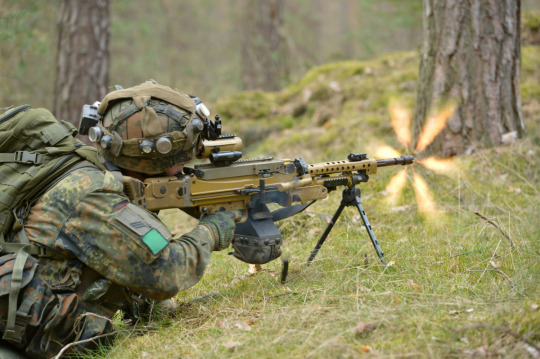
#german army#bundeswehr#nato#modern warfare#heckler & koch#military#firearms#panzergrenadier#infantry#armor#military history#infographic#battleorder
18 notes
·
View notes
Text
Breaking the Siege
Rulek’s face sneered when he saw one of the Imperial regiments’ cannon manage to crash against a fortification, sending it tumbling while the wall defenders were moving about. The summoned Blue Horrors returned their hail of flickering warpfire bolts across a great distance but the mortals were a bothersome lot with advancements into their gunpowder and munitions, distance were their salvation. They have been besieging the outpost for a month, enough to have a desperate lord send a fury for aid.
Now, the Daemon Prince - after his day of surveying and calculating - gestured. His outriders, fresh still of their torturing and entertaining of the Imperial scout battalion, were speeding along the deep snow with their mounts’ taloned feet barely sinking. They made barely a sound, the Dark Outriders were Rulek’s most trusted of Daemonettes that have served him since his conquest of the Norscan mountains. Even after his sundering, they remained true with him, even coercing that of another sisterhood of warlike pain-dancers that were now maneuvering, gliding through the shadows.
Rulek flexed his throats, exhuming a sharp sound that rolled with the flesh-cutting winds.
The mortals seemed to catch on to the sound but in the madness of the North, many unnatural sounds flowed through the winds but it was too late when they finally heard the buzzing of great wings coming from above. The exalted daemons of Nurgle laughed as their armoured rotflies swept on the already unnerved horses, throwing their riders off or snatching them with their long proboscis while Death’s heads were hurled into the riflemen not too far.
“Daemons! Daemons!” The cries relayed before the symphony of pain. The back lines were swept through by the Heartseekers giggling their sadistic glees and singing their desires. Their steeds bounce and kill as gracefully as their riders. The exalted Gilded Depravicants were not too far behind, catching the distractions of the infantry with a song of deprivation, their musks filling fearful nostrils and dazzling into further weaknesses.
The Southlanders were in a hurry, caught unaware of their flanks’ failure. This far from their precious lands and supply line severed some days ago. Rulek hunted little by little for this foolish expedition, now he came for their general and his men. The loud firing line of muskets going off. Swords to be drawn and halberds fighting to throw the daemonic calvary, but they found the black forests to be unveiling the true horror;
The legion of daemons and men were emerging with one great warcry known by many veterans of the Kislevite bulwarks and cultist incursions.
“BLOOD FOR THE BLOOD GOD! SKULLS OF THE SKULL THRONE!”
The crimson regiment of Chaos warriors armed with twinned axes and great shields partnered by the heralding charge of Bloodletters with their burning hellblades slamming into the defending formations, their fury twicefold at allowing the Slaaneshi to spill first blood and now desired to greaten their score. To turn the snow a melting crimson. For heads to be relieved from shoulders and to surpass their swifter cousins. Even while the rolling multitudes of giggling mischiefs in the form of Nurgle’s mites were biting and tripping soldiers into the many possibilities of ends.
Rulek cared not of their hatreds, for they bound to him and branded to know their master foremost. It was the only thing to keep them from turning on each other when they weren’t deep in the balm of war. The Daemon Prince himself flared his wings and took flight.
His wings beated solemnly but they carried his great form as easy as a soaring eagle. Gilded arms burning of gathering magics, Rulek released an abhorrent blight upon the mortal fools. Whilst brave men were lifting their shields, they bent, crumbled and exploded into glittering rust before cruel weapons. Their swords swung and halberds thrusted, only to become dust to infernal hide and armament.
What was a coordinated force became a death sentence in a moment, before the monstrous manipulator even landed in their midsts nor the defenders in the fortress to sally out to join in the slaughter.
Rulek claimed this victory and the Dark Gods knew, as they turned the cowardly lord within the wall into a cursing spawn to forever speak of the failure of champions and sing the praises of true Lords of Chaos through his nine maws.
0 notes
Text
Galveston County Texas Property Taxes 2023
The first recorded use of a railroad automotive for cell artillery occurred when Galvestonians defending the harbor mounted a heavy gun on the railroad observe and pushed it alongside while firing on ships. Nonetheless, regardless of fortifications, the port proved indefensible. Galveston Island properties were closed up, and folks Galveston county property taxes and warehouses moved to the mainland. Thomas William House and William Marsh Rice were among those who moved their headquarters to Houston. Declining cotton costs decreased the value of slaves, and many were placed by their house owners on inland plantations.
You could benefit financially if you shift your debt away from the federal government and earn a large sum of money consequently. The information on WalletHub Answers is predicated on our greatest efforts, however it should not be considered financial, legal, or investment recommendation. Before you make any decisions Galveston county property tax, make positive you have hired an expert. This site doesn't host any advertising, but presents could appear once in a while. The content on this web page isn't reviewed or endorsed by any monetary establishment.
Harris County, which accommodates Houston and the encircling suburbs, has a few of the highest property taxes not simply in Texas, however in the entire country. The average effective property tax rate in Harris County is 2.13%, significantly higher than the national common. Texas levies property taxes as a share Galveston property tax of every home’s appraised worth. So, for example, if your total tax fee is 1.5%, and your home value is $100,000, you will owe $1,500 in annual property taxes. The average efficient property tax price in the Lone Star State is 1.60%, well above the nationwide average of zero.99%.
Galveston County is ranked 292nd of the 3143 counties for property taxes as a share of median income. Galveston County has one of the highest median property taxes within the United States, and is ranked a hundred and Property tax galveston county ninetieth of the 3143 counties so as of median property taxes. Get in-depth data on all of the factors that have an result on your focused property's taxes with a free account.
County members within the Mexican War included the Galveston Riflemen within the first Regiment of Texas Infantry, the Guards, Fusiliers, Artillery, and Coast Guards. The inauguration of a ferry service from Virginia Point to Eagle Grove on Galveston Island improved transportation in 1838, but rail transportation quickly changed water transport. The Galveston, Houston and Henderson Railroad was chartered in 1853 and completed to Houston in 1859.
0 notes
Text
Battlefield 2 project reality

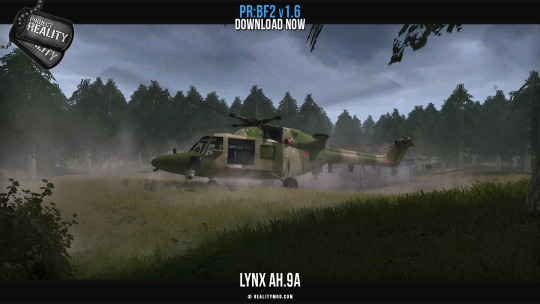
I will increase the number of officer-buildable mounted machine guns from 2 to 3, provided I can find out how. There's also an easter egg in the loading screen. There is one uncapturable point in the middle, players will have fun trying to snipe each other through the fog. Tad Sae is now a base building and defending map. Edits don't seem to be working though, so this might be a null edit. Once you place a mine, if you forget where it is, it will blow you up too) Previously, if you placed more than five, the next one would disappear. When playing as Vietnam-era Chinese or Vietnamese, you can place many more land mines than before, provided you refill your supply. Previously there was 1, but due to hooks glitching, disappearing, or just not going where they were supposed to go, players can have more. Players with grappling hooks have approximately 6 hooks. Riflemen can drop unlimited ammo refills, a-la battlefield 2 Supply crates heal players and refill ammunition faster. Previously, if people shot near you, your vision would blur for 4 seconds, per shot. Made it so that friendly names show up when you aim at friends that are close enough to identify by uniform. Did you know we can build base structures and defenses in game? Feel free to ask for help regarding anything in this thread! We have a Skype group going for notifications about when we'll be playing. Make sure to download the game via the torrent link, it's much faster that way. If you see AZ-Stalker, Zee Hypnotist and Wallywood in the Zee Hive channel on TeamSpeak, we're most likely playing so join in! That could brake Zee's mod and you'd be one version ahead of the rest of us.
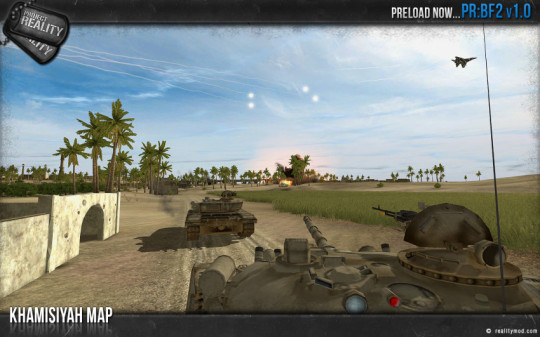
Don't update your game after you've already played with us. When setting up Zee's Mod, you'll have to open the game's individual archive files and then drag-drop-overwrite the mod files into each of them (about 4 times). You will not be able to play online or with anyone who doesn't have Zee's mod, but we do keep backups of the original files so just ask if you need them. We have cooperative fun, we do not play competitively. We always try to keep up a positive, fun and relaxing atmosphere while playing, so please act accordingly if you do get in a game with us. We do not intend on playing with people who are negative or have been causing trouble around W3D Hub or its game servers. This version is installed by just dropping the folders into the designated location (easy!) but the download itself is about 450mb in size. Here's an alternate download for Zee's mod if you're having trouble with the individual archive overwrites: (because that's where all of the awesome things happen)
Conn ect to the W3D Hub TeamSpeak server at ts.! (you don't need a microphone as long as you can listen in and respond via the in-game text chat).
(one of us has to invite you there first, so don't worry if you don't see it yet) (so we can add you into the party's room)
Add AZ-Stalker and ZeeHypnotist to your friends list on Evolve.
Download and install Evolve! (a simple LAN program which we use to connect everyone to our server).
Download and install Zee's mod! (this changes a few things so that the game is easier to play with less people).
Make sure your game is up-to-date! (the current game version is 1.3.9.0).
(decline if the launcher first asks you to make an online account, then you'll see the offline option)
Set up an offline account (choose a nickname).
Download and install Battlefield 2: Project Reality! (click the image under "Mod Downloads", then get the " PR:BF2 v1.3.5 Full" client).

Thinking about joining us? Already have the game set up? Want to see Wallywood attack an enemy tank with a shovel? Some of us W3D Hub staff members (and our friends) have been playing Battlefield 2: Project Reality these last couple of months every now and then, and would like to invite members of the W3D Hub community to join in on the fun and play with us! The game is a standalone total conversion of Battlefield 2 (2005) and is completely FREE! You do not need to own Battlefield 2! A free standalone game with great cooperative gameplay!

1 note
·
View note
Text
Muzzle loader

#Muzzle loader full#
Jackson went on to famously lead American riflemen during the War of 1812 to defend the young nation against insufferable trespasses and abuses by the United Kingdom that required Americans to fight to defend their country’s sovereignty and honor. By that time, he had fought in multiple duels to defend his wife’s honor and his own, including killing Charles Dickinson in a pistol duel on May 30, 1806, during which Jackson was also shot. Given Andrew Jackson's parents were Scottish-Irish immigrants and Jackson’s fiery character, the motto is certainly fitting for Old Hickory. The Latin motto "NEMO ME IMPUNE LACESSIT" on the banner in the eagle's beak on the patchbox means "no one provokes me with impunity" and is most famously the motto of the Stuarts and the Kingdom of Scotland as well as the Order of the Thistle and multiple Scottish organizations. at the time, cost the government around $25 each. For some context, the Ellis-Jennings four-shot repeating rifles, arguably the most advanced firearms in use by the U.S. A $100 rifle would certainly have been a high end piece. Harrington of Poughkeepsie, under the sign of an eagle, offered double and single barrel guns for $4.25 to $75, fine rifles for $10 to $100, "smooth rifles" for $9, pistols, a variety of muskets for $4 to $8, and an assortment of accoutrements. It was published on the same page as the town's proclamation of support for Andrew Jackson in the election of 1832 and notes that A.A. Harrington of Poughkeepsie, New York, who ran the "Poughkeepsie Gun Factory" also later known as "Harrington's Gun Manufactory." While researching this rifle, I found his June 2, 1832, dated advertisement in the Poughkeepsie Journal. It is believed to have come from the shop of A. Harrington New York flintlock full-stock rifle. Once you add the connection to the famous and controversial 7 th President of the United States of America, you have a firearm that is truly in a class of its own. Harrington of New York inscribed "Old Hickory" and attributed as owned by President Andrew Jackson.Ī rifle attributed to President Andrew Jackson, Hero of New Orleans.Įven without the “OLD HICKORY” inscription on the cheekpiece and thus the attribution to President Andrew Jackson, this incredible rifle stands as a magnificent example of American fine arms from the "Age of Jackson" and would be near the top of my list for the muzzle loaders in this sale. In my Top 10 video for the upcoming premier auction this rifle came in at number 1: a beautiful, German silver mounted full-stock flintlock rifle from A. I could bury this one at the bottom of the list and build up to arguably the top muzzle loading firearm in the sale, but it is simply too cool not to address at the top. Harrington Flintlock Rifle Attributed to Andrew Jackson
#Muzzle loader full#
The printed catalog, online portfolio, and the website version are great places to view the full descriptions and vivid photographs for each of these lots in detail. Instead of trying to cover everything, I'll whet your appetite focusing on some of my favorite pieces from the sale. Better yet, come to Preview Day on September 9th and see them all in person in our dedicated Preview Hall. With such a wide selection, it’s impossible to write an article that does the selection justice, so please scroll through Rock Island Auction Company's online catalog to see the sheer number and variety of firearms available. Ethan from I Love Muzzleloading discusses a Revolutionary War era Jacob Dickert flintlock American Long Rifle.

0 notes
Text
Empire total war factions

#EMPIRE TOTAL WAR FACTIONS FULL#
#EMPIRE TOTAL WAR FACTIONS PLUS#
In Africa, African Native Infantry provides a cheap alternative to Colonial Line. Additionally, in America, Mounted Tribal Auxiliary, Native Warrior Auxiliary, Native Bowmen Auxiliary and Native Musketmen Auxiliary provide some opportunities for different tactics as these units are better at hiding and skirmishing. Austria, France, Spain and Sweden can also recruit Colonial Light Cavalry a rare melee cavalry unit in the colonies. All factions can recruit Colonial Militia, Colonial Line Infantry and Colonial Dragoons in the early period. Generally, early period units are region specific, and then in the mid-period units transition to the factions’ European template. The colonies generally comprise anywhere that isn’t India or Europe. Artillery is at its peak in terms of power and sees the introduction of exotic weapons like puckle guns and rockets.
#EMPIRE TOTAL WAR FACTIONS FULL#
The full set of troop types threaten the dominance of the line infantry on the battlefield and combat will be more dynamic and flowing as a result. Mounted Guards are generally only available to Monarchies and many of these late troops have limited recruitment areas, generally "home" regions. This period sees the culmination of “modern” warfare in the form of elite Guards (foot and mounted), Light Infantry and Riflemen. The late period is the last three levels of major province buildings, the last being nation-unique levels which only bring unique units. Artillery has become more diverse and mobile (some drawn by teams of horses) and can be used tactically in offensive battles. Provincial cities can now produce core units allowing for bigger armies: Line Infantry, Regiment of Horse, Dragoons and Lancers. These provide more option for rapid flanking and artillery destruction than in the earlier period. Cavalry forces become more diverse and important, with the introduction of light cavalry Hussars, Light Dragoons, Heavy Cavalry and Cuirassiers. Line infantry gain advances in firing drill and bayonet, and Grenadiers provide a superior option, both in melee and shooting, bringing some variation to the Line of Battle. This brings more tactical variation to army composition, and national differences become more pronounced. In the middle period, covering the next two levels of government and military buildings (representing the highest level for minor provinces), more specialised unit types are introduced. Battles will be more often decided by quantity rather than quality. Artillery is initially static, a defensive weapon, but some slow mobile cannons appear. In addition to their melee value, they are fast cavalry. Some nations obtain lancer cavalry which can be decisive in this period before advanced bayonets. However, technology unlocks Dragoons and Carabineers (nations get one or the other) which give an extra tactical option. Cavalry starts with utilitarian Regiment of Horse and Provincial Cavalry - all round useful, but not decisive. Pikemen are still useful until bayonets arrive to enable standard infantry to replace them. Infantry will be composed of Militia, supplemented with Line Infantry from large cities which will be the deciding factor of battles.
#EMPIRE TOTAL WAR FACTIONS PLUS#
The early period covers the first two levels of government (up to Governor's’ Residence) and military buildings (to Barracks), plus available technology.

0 notes
Photo

5 OCTOBER 1813 - After the American recapture of Detroit by Major General William Henry Harrison, U.S. Army forces crossed into Upper Canada in pursuit of the retreating British army commanded by Major General Henry Proctor. Proctor chose to make a stand on the Thames River near Moraviantown, about 75 miles east of Detroit; he arranged his force with regulars on the left and allied-Indian warriors commanded by Tecumseh on the right on a line behind a narrow swamp between the Thames River and a more extensive swamp on his flanks. Harrison made his main attack against the British troops with a regiment of Kentucky mounted riflemen while a brigade of Kentucky militia infantry attacked the Indian warriors. The mounted riflemen, led by Colonel Richard M. Johnson, were a "select militia" unit of volunteers armed with long rifles and tomahawks. Their attack surprised and scattered the enemy army -- British regulars, and Indian warriors alike. The Kentucky soldiers saw the Battle of the Thames as revenge for a massacre of Kentucky militia soldiers at the Battle of the River Raisin in January 1813. U.S. forces occupied that area of Upper Canada until the end of the War of 1812 when it was restored to the British under the terms of the Treaty of Ghent. #Armyhistory #USArmy #TRADOC #MilitaryHistory #Tecumseh #ThamesRiver #UpperCanada #thisdayinarmyhistory Posted @withrepost • @armyhistory (at Middle Tennessee Area) https://www.instagram.com/p/CjVOdy6uvj7/?igshid=NGJjMDIxMWI=
0 notes
Photo

“One of the new defenders of the far northwest territories of Manchuria — a Mongol cavalryman. These camel-mounted riflemen, natives of the Barga region recently occupied by Japanese force which routed the insurgent Chinese General Su-Ping-Wen, have been enrolled in the new defence corps of the district.”
- from the Kingston Whig-Standard. January 9, 1933. Page 3.
#operation nekka#defense of the great wall#inner mongolia#mongols#invasion of manchuria#manchukuo#japanese imperialism#imperial japan#collaboration#cavalry#imperial japanese army#sino-japanese war
10 notes
·
View notes
Photo

Lieutenant of the King of Saxony’s Regiment of Mounted Riflemen, 1898-1905, Germany, plate by Carl Becker
44 notes
·
View notes
Photo






Greene Breech-Loading Percussion Carbine
In 1854, James Durell Greene of Cambridge, Massachusetts, patented a novel hinged breech carbine design. Greene’s breech-loading percussion carbine used a self contained cartridge which could be placed into the open breech.
In the mid-1850s the British Army took interest in Greene’s design. Following a successful trial of the weapon at the British Army’s School of Musketry at Hythe an order for 2,000 .54 calibre Greene carbines was made. This contract was reportedly to equip the Cape Mounted Riflemen - a South African colonial yeomanry battalion which was extensively involved in the late Xhosa or Cape Frontier Wars. The need for a carbine which could be quickly loaded could make the difference between life and death when fighting enemies as numerous and adept as the Xhosa. The carbines were likely ordered at just after the Eighth Xhosa War (1850–53). Other sources suggest the Cape became the carbines’ destination after the end of the Crimean War (1853-56).

The Cape Mounted Riflemen in action during the Eighth Xhosa War (source)
The carbine was a single shot, breech-loading, percussion carbine with three groove rifling and an 18 inch barrel. To load Greene’s carbine the user pulled the front trigger to release the barrel, grasped the barrel and twisted it 90 degrees counter-clockwise. This rotated the barrel lugs out of alignment with the locking shoulders and allowed the barrel to be pulled forward approximately an inch. The barrel could then pivot to the right, swinging down to allow clear access to the breech. Once the breech was open a self-contained paper cartridge, including powder and projectile, could be loaded. The barrel was then swung back up into position and the barrel sharply pulled to the rear. This would allow an ignition cone to pierce the base of the cartridge and allow the user to rotate the barrel clockwise and lock the breech. The hammer could then be cocked and Maynard’s Tape Primer system would place a primer over the carbine’s nipple ready to fire.
The operator could then pull the trigger, sending the hammer forward onto the primer tape. The ignition from the primer travelled down the ignition cone and ignited the cartridge.

Patent drawing showing Maynard’s ‘Primer Cock’ (source)
Another interesting feature of the Greene carbine was the use of Edward Maynard’s patented Tape Primer system (see image #6). Maynard’s Tape Primer included a magazine which fed a tape of mercury fulminate primers into position each time the hammer was cocked. This would certainly have been useful for a cavalryman who might potentially struggle to cap his weapon while on horseback while in action. The carbine could also be primed with traditional percussion caps circumventing the tape primer magazine The US Army universally adopted Maynard’s primer system for the Model 1855 Rifle-Musket.

Diagram from Greene’s patent showing how the ignition cone pierces the base of the paper cartridge (source)
The carbines were produced by the Massachusetts Arms Company and shipped to Britain for proofing and testing. Their testing found that the design’s weak point was its ammunition. The rudimentary self-contained paper cartridge used by the carbine was too thick for the ignition cone to penetrate or conversely too brittle if the cartridge could be easily penetrated. As a result the Cape Mounted Riflemen never received the carbines.
They were held in the Tower armoury while attempts were made to produce suitable ammunition and eventually sold off as parts. It appears that some were issued for troop trials with some of the carbines marked ‘RDMR’ - which some have hypothesised could be the Royal Devon Mounted Rifles or the Riversdale District Mounted Rifles - I have been unable to confirm the existence of either of these units or find another unit which fits the initials.
The US Army, who purchased approximately 300 for testing, also lost interest in the design finding the hinged barrel difficult to manipulate on horseback. In the late 1850s Greene also developed the Greene Breech-loading rifle which used an early bolt action. He was granted a patent for this design in early 1862, several thousand were produced by the A.H. Waters Armory. During the Civil War he served as a Lieutenant Colonel with the 5th Massachusetts Militia and later commanded the 17th and 6th Infantry regiments. He was brevetted Brigadier General before retiring in 1867. In 1869, he patented a ‘life preserving mattress’ flotation aid.
He returned to the firearms trade filing numerous patents including a rotary magazine repeating rifle in 1885. Greene died in 1902, aged 74.
Sources:
Images: 1 2 3 4 5 6
‘Breech-Loading Fire-Arm’ US #11157, J.D. Greene, 22 June 1854, (source)
‘Priming Cock’, US Patent #4208, E. Maynard, 22 Sept. 1845, (source)
British Rifles: Catalogue of the Enfield Pattern Room, H. Woodend (1981)
If you enjoy the content please consider supporting Historical Firearms through Patreon!
#History#Military History#Firearms History#Greene Carbine#Carbine#Firearms#James Durell Greene#British Army#Xhosa Wars#Colonial History#Cape Frontier Wars#Cape Mounted Riflemen#Edward Maynard#Massachusetts Arms Company#Firearms Design#Firearms Development#Weapons#US Army#gunblr#Breech loader#Breech loading rifle#Crimean War
84 notes
·
View notes
Text
The (In)Effectiveness of American Rifles during the Revolutionary War

Arguably no weapon looms as large in American’s past as the “long” rifle of the eighteenth century. Popular history holds that rugged American frontiersmen used these pinpoint-accurate firearms to snipe British officers and wreak havoc during the Revolutionary War. Reality is sadly somewhat more prosaic. While the rifle was a valuable weapon, it didn’t win the war for the revolutionary cause – arguably, it made little difference in a conflict that was decided by smoothbore-armed regulars fighting in a largely traditional style.
One of the most fascinating aspects of the rifle in the Revolution is the fact that the hype still surrounding it wasn’t manufactured after the war – it was very much a craze during the conflict itself. Rifle mania swept both America and Britain, especially early in the conflict. Stories of the fearsome accuracy, and general hardiness, of Continental Army rifle companies abounded. British soldiers and officers genuinely feared they would be decimated by the weapon.
Actual use in combat, however, quickly highlighted the shortcomings of what had largely originated as a hunting weapon, rather than a military firearm. Rifles took too long to load and lacked the ability to mount a bayonet. British combat doctrine was quickly adapted to emphasise close combat over firefights, where the revolutionaries had the advantage. Riflemen couldn’t put out enough lead to halt a determined charge, and had to retreat due to their own lack of bayonets.
Good revolutionary commanders soon learned that rifles were best used in tandem with infantry armed with smoothbore muskets and bayonets, as emphasised by the man most associated with riflemen during the war, Daniel Morgan;
“My riflemen would have been of little service if they had not always had a line of musquet and bayonet men to support us; it is this that gives them confidence. They know, if the enemy charges them they have a place to retreat to.”
Morgan used riflemen with his regular infantry to devastating effect at Cowpens, and rifle-armed militia likewise combined well with regular Continentals at Guildford Courthouse. It was also possible for riflemen to simply withdraw before an enemy charge and then come back when the attack had spent itself, such as at the battle of Freeman’s Farm, a tactic that led British officers to likening riflemen to clouds of hornets. That, however, was often easier said than done – it wasn’t uncommon for riflemen driven back by a bayonet charge to simply leave the battlefield and not return.
The British also learned that rifles weren’t as superior to smoothbores in terms of accuracy as some of their proponents – and almost every pro-revolutionary newspaper – claimed. After the battle of Long Island one British light infantry captain wrote;
“Having fallen in with about 400 Rifle men unawares, they are not so dreadfull as I expected or they must have destroyed me and my whole Company before we were supported.”
·
After another clash; “Tho’ there’s no people in the World can shoot Black Ducks better, but the Ducks carry no Firelocks and Bayonets...they are convinced that being a good Marksman is only a trifling requisite for a Soldier... I myself saw then beat as Marksmen. I was engaged… with a 150 Riflemen for upwards of 7 hours at their favorite Distance about 200 Yards, they were better cover’d, having a house a Mill and a Wall...they got the first fire at us before I saw them, I bid my Men cover themselves with the Trees and Rocks and turn out Volunteers among the Soldiers to go to the nearest Trees to the Riflemen and keep up the Fire… I continued the popping fire at them and they at us we had the Satisfaction of knocking several of them down and had not a Man hurt. They at last fairly gave up firing finding themselves beat in their own way, which shew’d a cool Soldier with a good Firelock was beyond a Rifleman with all his Skill but such a Bugbear were they at first our good Friends thought we were all to be kill’d with Rifles.”
This attitude was mirrored by Revolutionary commanders. At several points during the war George Washington ordered that riflemen replace their weapons with smoothbore muskets and bayonets. In 1776 Continental general Charles Lee despaired at riflemen firing at what he called “preposterous” ranges. He issued strict orders that “no man should fire his weapon at a distance greater than 150 yards” and only when they were sure of hitting their mark. Another Continental general, Anthony Wayne, put it perhaps most clearly; “I don’t like rifles – I would almost as soon face an Enemy with a good musket and Bayonet without ammunition. The Enemy knowing the Defenseless State of our Riflemen rush on…this would not be the Case if the Riflemen had bayonets – but it would be better still if good muskets and bayonets were put into the hands of good Marksmen and Rifles entirely laid aside – for my own part I never Wish to see one.”
Of course, rifles did score notable kills, most famously British brigadier general Simon Fraser who was shot by an unknown riflemen at Bemis Heights in 1777. However, like the death of Brigadier James Webster not long after Guildford Courthouse, his was largely an outlier. In the eight years after Bunker Hill (where the British officer corps was devastated, interestingly by smoothbore-armed militia), the British Army didn’t suffer higher casualties among its officers than it did in other eighteenth century wars. Losses among senior officers were rare.
To wrap it up - riflemen did serve a purpose and did advance the revolutionary victory especially as part of a combined arms approach, but their effectiveness pales in comparison to how they were popularly viewed both at the time and since.
#american revolution#revwar#american war of independence#history#18th century#military history#rifle#rifles#long rifle#nra
48 notes
·
View notes
Text

🇬🇧 The current British Army Infantry Section, factoring in organizational changes from 2018 and new modifications to the L85A3.
---Structure---
⚔ The British Infantry Section consists of 8 men split into two fire teams (Charlie under the Section Commander and Delta under the Second-in-Command). Who goes in what fire team depends on the situation and preference, but generally the Section 2iC leads any sort of support-by-fire element (which normally includes the L7A2 general-purpose MG; sometimes the Sharpshooter as well). Other than leadership, key personnel include a Sharpshooter, 2 Grenadiers, 1 GPMG Gunner, and 2 Riflemen. Infantry Platoons are compoed of three such sections, in addition to a small Platoon HQ.
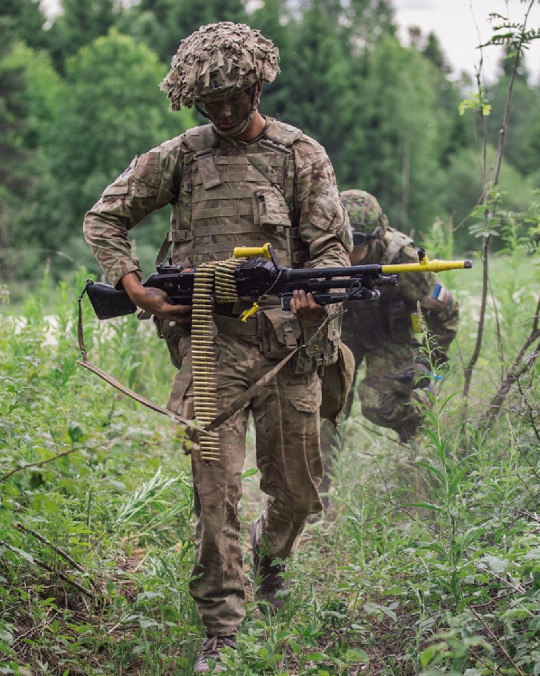
---Equipment---
⚔ The standard service rifle is the L85A3, which is gradually replacing the L85A2. This graphic includes the new M-LOK handguards, replacing the KeyMod handguards it was adopted with. It also shows the new mounting system for the L123A3 grenade launcher. Previously, the old L85A2 mounting system was still being used on the L85A3.
⚔ The Sharpshooter is equipped with the L129A1, an LMT-produced rifle that replaced the L86 LSW in a designated marksman role in 2009. In 2018, the L7A2 GPMG was reintroduced to the section (having been taken out in the late-1980s), coinciding with the removal of the L110A1 LMG (version of the FN Minimi). The rationale was that the British trials unit stated that the Minimi was ineffective past 250 meters. Whether this is actually true or not, the Army decided it was not worth the weight burden to keep the Minimi in the section for that limited capability. The basic theory is the grenade launcher and rifle can suppress targets at shorter ranges, the sharpshooter can offer accurate point suppression at longer ranges, and the GPMG can offer area suppression at longer ranges. The area suppression role is why British L7A2s lack optics.
⚔ NLAW anti-tank guided missiles are available to each section. Depending on operational need, Glock 17 pistols can be issued to the section (as was seen in Afghanistan). This may be seen for future COIN deployments.

#gpmg#british army#infantry#ally#nato#military#military history#firearms#infographic#l85#paratroopers#airborne#battleorder
17 notes
·
View notes